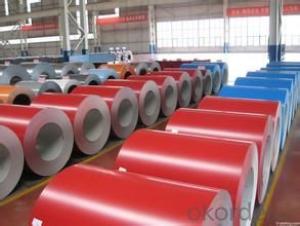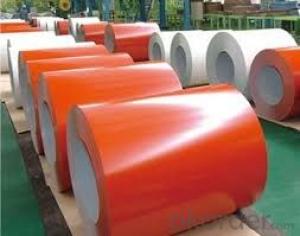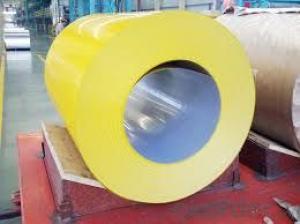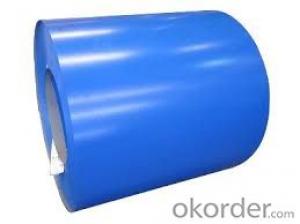Prepainted Galvanized Rolled Steel Coil from China
- Loading Port:
- Tianjin
- Payment Terms:
- TT OR LC
- Min Order Qty:
- 100 m.t.
- Supply Capability:
- 500000 m.t./month
OKorder Service Pledge
OKorder Financial Service
You Might Also Like
Description Of Prepainted Galvanized Steel:
Prepainted Galvanized Steel usually refers to have substrateprocessed with surface processed and coated then(roller coated )or bonded organic thin film and baked, and it is able to be processed tofinal prodevtion .
Specifications Of Prepainted Galvanized Steel:
Thickness 0.20-1.2mm (BMT) Width 600-1250mm |
Zinc Coating 100-275g/m2 |
Color According to RAL color fan or as per request |
Internal Diameter 508mm or 610mm |
Coil Weight 3-6MT |
Quality Commercial and structural quality |
Paint Polyester paint for topside, epoxy for reverse |
Standard JIS G 3312, ASTM A755M, EN 10169 |
Base Steel Grade SGCC,SGCD,DX51D+Z,DX52D+Z;S200GD,S220GD,S280GD,S350GD,CS,FS,SS |
Applications Of Prepainted Galvanized Steel:
It can be widely used in transportation, light industry, civil usage and farming. It is also the perfect building material in construction for making steel roofing,insulation panel, corrugate sheet, facade wall,shutters,T-bar and home appliance.
Packaging & Delivery Of Prepainted Galvanized Steel:
The packing of coils consists of anti-damp paper, PVC film, hardboard paper, steel box, strapped with steel strips, fitted with locks and edge protectors and guarantees the optimal condition of the delivered goods. Each coil can be additionally fitted with wooden/steel skids(eye to the side) or wooden pallets(eye to the sky).
Images of Prepainted Galvanized Steel:
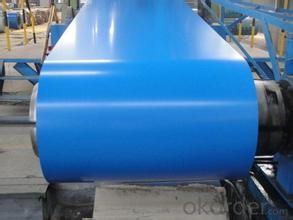
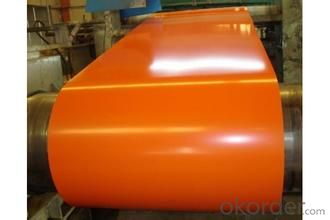
- Q:I was reading about the Colt 38 Super Custom and it said it's optional between a carbon steel frame or a stainless steel frame. What is the difference? There is also a choice between aluminium or stainless steel hammers and triggers can you also tell me the difference between them please?
- Carbon steel will corrode much more easily than stainless steel, and stainless can be made stronger than carbon steel. Stainless steel is also usually heavier than carbon steel, which helps to control recoil when the gun is fired (recoil is not eliminated, only reduced). Stainless steel can also be polished to a mirror finish, so it doesn't have to be chrome-plated for that shine. Probably the biggest plus to using stainless over carbon steel, though, is the fact that it is far less prone to crystalization than carbon steel. When steel crystalizes, it becomes brittle, and can break at the worst possible times. Bad thing about stainless: It generally costs more. Aluminum is much lighter than any steel, size-for-size, and can be just as strong, if not stronger, than steel; I've worked with aluminum alloys that require special-made tooling. The difference, besides the weight issue, is that aluminum (even most alloys) will become softer when it is heated to a specific point -- which is why it is not used for the barrels of firearms using explosive powders as the propellent source. Because of the cost of the alloys which can withstand the heat generated in the barrel of a firearm, it is just less expensive to use a steel barrel. And for a fella that is so pro-gun, the previous answerer sure seems ignorant of 'em.
- Q:What are the factors that affect the quality of steel coils?
- The quality of steel coils can be influenced by various factors. To begin with, the composition of the steel itself plays a vital role in determining its quality. Impurities like sulfur or phosphorus can have a negative impact on the strength, durability, and overall performance of the steel. Additionally, the quality of the steel is affected by its carbon content, alloying elements, and heat treatment. Furthermore, the quality of the steel coils is greatly affected by the manufacturing process and techniques utilized during production. Factors such as the cleanliness of the production environment, the precision of the rolling and cooling processes, and the control of temperature and pressure throughout manufacturing all contribute to the final quality of the coils. Additionally, the surface quality of the steel coils is a crucial factor. Any defects or imperfections on the surface, such as scratches, dents, or corrosion, can compromise the integrity and functionality of the coils. It is essential to handle, store, and transport the coils properly to maintain their surface quality. Moreover, the mechanical properties of the steel coils, including tensile strength, yield strength, and elongation, are essential indicators of their quality. These properties depend on various factors, such as the type of steel, its thickness, and the processing conditions. Lastly, external factors such as environmental conditions, like humidity and temperature, can affect the quality of steel coils. Exposure to moisture or extreme temperatures can lead to corrosion or other forms of degradation, impacting the overall quality and lifespan of the coils. In conclusion, the quality of steel coils is influenced by several factors, encompassing the composition of the steel, the manufacturing process, surface quality, mechanical properties, and external environmental conditions. It is crucial to carefully control and monitor these factors to produce high-quality steel coils that meet the desired specifications and standards.
- Q:Can i make holes in iron and steel with somekind of drill bit. All i have is metal drill bits. Mabey like 68 of them but i dont know wich one to use and if they will penetrate.
- That's what drill bits are made for. Those for steel and iron will usually be made of high speed steel. What is important, is the sharpening, and of course, the overall condition of the drill bit. If you need to drill a larger hole, it is helpful to drill a small hole first (pilot drilling), then open it out to size. Never use drill bits you intend to drill iron or steel with to drill such as timber! It will ruin them for steel working.
- Q:and also what makes different hardness of stainless steel?
- The person above me is right .The stainless steel is used in shaving blades
- Q:I am in the market for a good hunting knife under $100. I am primarily looking for a knife that will keep it's edge. What type of steel should I be looking for?
- Regardless of who makes the knife, you might look at stainless steel instead of the better tool steels like O2,M2 or D2...stainless takes more abuse and neglect than the others do.
- Q:What are the different types of steel coil handling attachments?
- There are several different types of steel coil handling attachments that are commonly used in industrial settings. These attachments are designed to safely and efficiently handle steel coils of various sizes and weights. One type of steel coil handling attachment is the coil lifter. This attachment is typically made of durable steel and is designed to securely grip the steel coil. It features a set of adjustable arms or hooks that can be positioned to fit the specific size and shape of the coil. Coil lifters are often used in conjunction with cranes or other lifting equipment to safely transport steel coils. Another common type of attachment is the coil grab. Similar to a coil lifter, a coil grab is used to securely grip and lift steel coils. However, coil grabs often feature a more compact design and are typically used in applications where space is limited. They can be operated manually or attached to a crane or forklift. Additionally, there are coil tongs that are specifically designed to handle smaller steel coils. These tongs are often used in manufacturing or processing facilities where coils need to be lifted and moved within a confined space. Coil tongs typically feature a set of adjustable jaws that can be positioned to grip the coil securely. In some cases, magnetic attachments are used to handle steel coils. These magnets are designed to attract and hold onto the steel, allowing for easy lifting and transportation. Magnetic attachments are often used in applications where other types of attachments may not be suitable, such as in environments with extreme temperatures or where the steel coils are coated. It is important to note that the specific type of steel coil handling attachment used will depend on the size and weight of the coils, as well as the specific requirements of the application. Industrial equipment suppliers can provide guidance on selecting the most appropriate attachment for a particular situation.
- Q:How are steel coils protected against bending and deformation?
- Various measures are implemented to safeguard steel coils from bending and deformation. One prevalent approach entails employing protective packaging materials, such as wooden crates or metal skids. These materials provide stability and support, effectively preventing any bending or deformation during transportation or storage. Additionally, steel coils are frequently tightly secured using steel or plastic bands. This measure serves to maintain their shape and prevent any shifting or movement. These bands are strategically positioned at regular intervals along the length and width of the coils, guaranteeing even pressure distribution and minimizing the risk of bending or deformation. Furthermore, steel coils can be further shielded by placing them on a flat and level surface during storage or transportation. This practice ensures the even distribution of weight, thus reducing the likelihood of bending or deformation due to uneven pressure. In certain instances, steel coils may also be coated with anti-corrosion agents. This protective coating shields against moisture and rust, which can weaken the structural integrity of the coils and lead to bending or deformation over time. In conclusion, the combination of appropriate packaging, secure fastening, and careful handling is paramount in safeguarding steel coils against bending and deformation. This comprehensive approach ensures the maintenance of their structural integrity and quality.
- Q:What is the standard thickness of steel coils?
- The standard thickness of steel coils can vary depending on the specific application and industry. However, common thickness ranges for steel coils typically fall between 0.015 inches (0.38 mm) and 0.125 inches (3.17 mm).
- Q:How do steel coils contribute to the construction sector?
- Steel coils contribute to the construction sector in several ways. Firstly, they are used to manufacture structural components such as beams, columns, and steel frames, which provide strength and support to buildings and infrastructure. Secondly, steel coils are used to produce reinforcement bars that are embedded in concrete, enhancing its tensile strength and durability. Additionally, steel coils are utilized in the construction of bridges, pipelines, and other large-scale projects that require robust and long-lasting materials. Overall, steel coils play a vital role in the construction sector by providing the necessary materials for sturdy and resilient structures.
- Q:What are the main steel coil producing countries?
- The main steel coil producing countries are China, Japan, India, the United States, and Russia.
1. Manufacturer Overview |
|
|---|---|
| Location | |
| Year Established | |
| Annual Output Value | |
| Main Markets | |
| Company Certifications | |
2. Manufacturer Certificates |
|
|---|---|
| a) Certification Name | |
| Range | |
| Reference | |
| Validity Period | |
3. Manufacturer Capability |
|
|---|---|
| a)Trade Capacity | |
| Nearest Port | |
| Export Percentage | |
| No.of Employees in Trade Department | |
| Language Spoken: | |
| b)Factory Information | |
| Factory Size: | |
| No. of Production Lines | |
| Contract Manufacturing | |
| Product Price Range | |
Send your message to us
Prepainted Galvanized Rolled Steel Coil from China
- Loading Port:
- Tianjin
- Payment Terms:
- TT OR LC
- Min Order Qty:
- 100 m.t.
- Supply Capability:
- 500000 m.t./month
OKorder Service Pledge
OKorder Financial Service
Similar products
New products
Hot products
Related keywords

